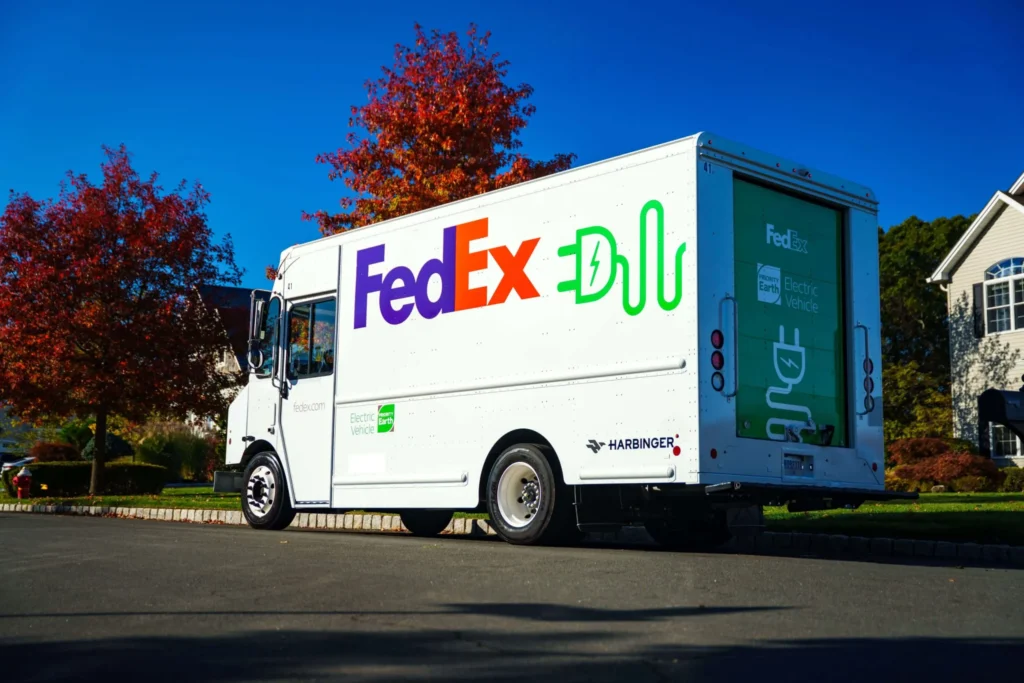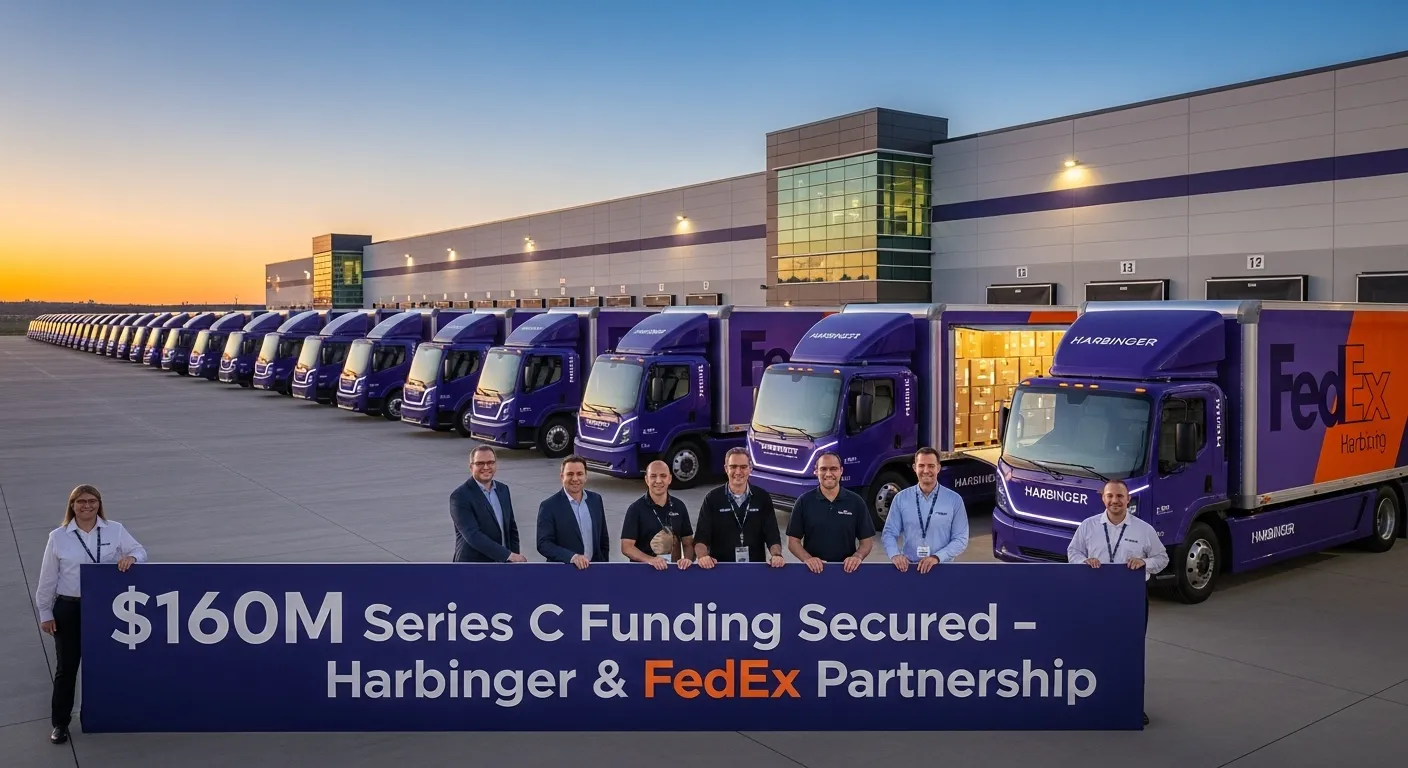Table of Contents
Electric vehicle adoption in commercial fleets just crossed a critical threshold. FedEx announced a pivotal partnership with Harbinger Motors, securing an initial order for 53 electric trucks while also co-leading the startup’s $160 million Series C funding round. The deal, completed November 2025, signals a major shift in last-mile delivery logistics.
This isn’t speculative investment, it’s a working fleet deployment backed by one of the world’s largest delivery networks. Harbinger’s ability to deliver vehicles at acquisition parity to diesel competitors while offering lower total cost of ownership fundamentally changes medium-duty truck economics.
For an industry accustomed to decades-old internal combustion platforms, this collaboration marks the moment electrification moves from pilot programs to operational scale.
The Funding Round: Scale Over Skepticism
Co-Investors Signal Market Maturity
The Series C round attracted heavyweight backing beyond FedEx. THOR Industries, a leading recreational vehicle manufacturer, and Capricorn Investment Group’s Technology Impact Fund co-led the financing. This diversified investor base spanning delivery logistics, manufacturing, and impact capital suggests confidence extends beyond fleet operators.
The funding brings Harbinger’s total raised to $358 million since 2021. January 2025 saw a $100 million Series B round, meaning the company has doubled funding capacity within ten months.
The speed matters. Medium-duty electric trucks remained fragmented across dozens of startups and retrofit operations until recently. FedEx’s dual commitment investment and firm purchase order eliminates buyer uncertainty. Capricorn’s managing partner noted that:
“the industry is now ready to move to mass adoption, with Harbinger leading that scale up.”
That statement reflects a fundamental market shift: electrification is no longer a sustainability checkbox but a competitive cost advantage.
Why Medium-Duty Vehicles First
Harbinger’s focus on Class 5 and Class 6 trucks addresses an underserved market segment. These vehicles handle 80% of use cases suited for full electrification, according to the company’s analysis. Unlike long-haul heavy-duty trucks requiring multi-day range, medium-duty vehicles perform predictable routes typically last-mile delivery and return to central facilities for overnight charging.
This operational pattern eliminates range anxiety while enabling cost-effective Level 2 charging infrastructure.
The FedEx order includes 53 vehicles with delivery beginning in 2025. This represents tangible production capacity. Harbinger isn’t announcing aspirational targets; it’s committing to near-term delivery timelines.

The FedEx Bet: Carbon Neutral Operations Meet Economics
Fleet Electrification as Operational Strategy
FedEx manages over 200,000 ground vehicles globally. The company set a target for carbon-neutral operations by 2040, supported by a commitment to convert its entire parcel pickup and delivery fleet to zero-emission electric vehicles.
More than 8,000 electric vehicles currently operate across the FedEx network, including e-cargo bikes and trikes. The new 53-unit Harbinger order fits into a broader pattern: FedEx also ordered 150 Blue Arc electric trucks from Shyft Group for higher-capacity applications.
Paul Melander, Senior Vice President of Safety and Transportation at FedEx, framed the decision clearly: “Any vehicle that holds up to our rigorous on-road testing and offers state-of-the-art safety features with lower total cost of ownership is win-win for drivers and for our business.” This statement reveals FedEx’s decision matrix. It’s not greenwashing performance, price, and reliability determined the purchase.
Why Total Cost of Ownership Matters
Harbinger vehicles feature a 10-year warranty covering battery, motor, and frame alongside reduced maintenance requirements. Electric powertrains eliminate oil changes, transmission fluid, and other consumables that plague diesel operations.
The company estimates lower total cost of ownership versus diesel equivalents. For fleet operators managing thousands of vehicles, TCO compounds across every unit a 5% savings per truck translates to millions across a large fleet.
Acquisition price parity is crucial. FedEx noted Harbinger vehicles’ “state-of-the-art safety features with lower total cost of ownership” no reference to subsidies or premium pricing. This reveals that Harbinger’s vertical integration manufacturing motors, batteries, and chassis in-house achieves cost targets without external support.
Vehicle Specifications: Engineering for Real-World Delivery
Battery and Range Configuration
The initial FedEx order targets Class 5 and Class 6 vehicles, the workhorses of urban and suburban delivery networks. Harbinger offers three battery configurations: 140 kWh (225 km range), 175 kWh (281 km range), and 210 kWh (338 km range).
This modular approach lets operators match battery capacity to duty cycles higher-volume urban routes use smaller packs; longer regional routes use larger systems.
For reference, a typical last-mile delivery vehicle averages 50-100 miles daily within city boundaries. Even the base 140 kWh configuration exceeds operational range requirements, with overnight charging feasible across standard facility electrical infrastructure.
Performance and Design
Harbinger engineered vehicles from the ground up as electric platforms rather than retrofitting existing diesel designs. The double-wishbone front suspension improves maneuverability with a 12.8-meter turning diameter essential for tight urban streets.
Step-in height sits below 28 inches, accommodating drivers making approximately 200 stops per day with minimal fatigue. The motors deliver up to 13,400 lb-ft of torque at the wheel, ensuring responsive acceleration in congested delivery zones.
These specifications address real operational pain points. Retrofit electrification often sacrifices interior space or driver ergonomics. Harbinger’s purpose-built architecture eliminates those trade-offs.
Industry Implications: From Pilots to Production
Breaking the Medium-Duty Logjam
The medium-duty truck segment remained largely untouched by electrification for years. Large fleets deployed demonstration units testing, learning, delaying scale while manufacturers debated technology approaches.
FedEx’s committed order of 53 units signals the pilot phase has ended. Other operators now face pressure to evaluate Harbinger’s competing total cost economics.
The company also launched Canadian operations in October 2025, announcing electric step vans with Morgan Olson and Utilimaster as third-party upfitters. This geographic expansion suggests production capacity supports multiple fleet orders simultaneously.
Competition and Hybrid Options
Not every route fits pure-electric profiles. Harbinger’s hybrid variant addresses the remaining 20% of use cases longer routes, multi-shift schedules, or limited charging access. The hybrid leverages the same electric chassis paired with a gas-powered range extender, offering up to 804 kilometers of range. This dual offering broadens addressable markets beyond optimal electrification scenarios.
Competitors including Lightning eMotors and other medium-duty EV makers now compete on performance and price against established references.
Scale, Infrastructure, and Market Timing
Charging Infrastructure as Competitive Moat
FedEx is simultaneously investing in charging infrastructure and collaborating with utilities to build grid capacity. This acknowledges a reality: vehicle electrification cannot scale without corresponding charging networks. The company’s multi-facility charging strategy centralized overnight charging at distribution hubs aligns perfectly with Harbinger’s design parameters.
The timing reflects growing grid readiness. Utility companies and fleet operators now partner proactively rather than reactively, unlike pilot phases of 2020-2023. FedEx’s investment signals confidence in infrastructure maturity.
Market Adoption Trajectory
FedEx’s current target: 50% of all new parcel pickup and delivery vehicle purchases will be electric by 2025, reaching 100% by 2030. The Harbinger order contributes to this ramp, though it represents only a fraction of annual PUD vehicle acquisitions across FedEx’s global network. This suggests larger follow-on orders are likely if initial deployment performance meets operational standards.
Capricorn’s investment thesis emphasized that “medium-duty truck fleets have generally deployed small volumes of demonstration electric trucks over the last two decades,” but “the industry is now ready to move to mass adoption.”
This assessment aligns with observable market data: electrification has shifted from venture-funded startups to operational partnerships with multinational logistics providers. Learn more in our article on Freightliner Business Class M2 106: Specs, Features & Best Use Cases Explained.
Bottom Line
The FedEx-Harbinger partnership represents a critical milestone rather than an outlier. A $160 million funding round backed by an operational fleet commitment demonstrates investor and operator confidence in Harbinger’s technology and economics. Medium-duty electric trucks are transitioning from prototype discussions to production deployments with defined timelines and performance standards.
FedEx’s commitment to carbon-neutral operations by 2040, coupled with aggressive 2025-2030 electrification targets, means Harbinger will likely deploy thousands of additional vehicles across this decade. For other logistics operators, this deal creates competitive pressure: customers expect electrification roadmaps; suppliers must offer credible alternatives.

